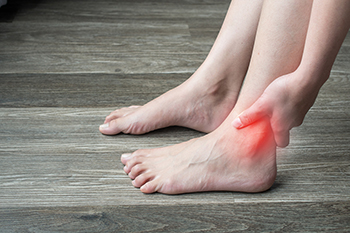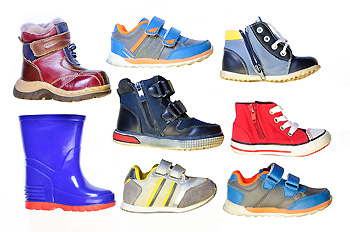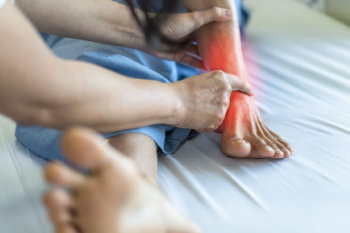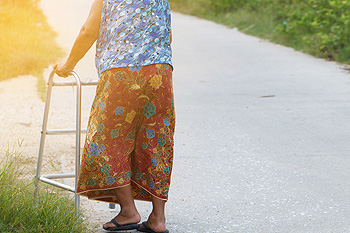August 2024
Do Your Child's Feet Hurt?
All About Ankle Pain

Ankle pain can stem from various issues affecting the complex structure of the ankle, which includes bones, ligaments, tendons, and muscles. The ankle joint comprises the tibia and fibula bones of the lower leg, which connect to the talus bone in the foot. Ligaments stabilize the joint, while tendons enable movement. Common causes of ankle pain can include sprains, arthritis, and fractures. Sprains occur when ligaments are stretched or torn, often due to twisting injuries. Strains involve overstretching or tearing of tendons or muscles. Arthritis can lead to inflammation and stiffness, while fractures result from trauma or severe impact. To alleviate ankle pain, consider resting the ankle to reduce swelling and discomfort. Mild pain relievers like ibuprofen may also help to provide temporary relief. For persistent or severe pain, it is suggested you contact a podiatrist for professional medical advice, as more advanced treatments may be necessary to address the underlying issue and restore function.
Ankle pain can have many different causes and the pain may potentially be serious. If you have ankle pain, consult with Naim G. Shaheed, DPM from Ankle and Foot Centers of Georgia. Our doctor will assess your condition and provide you with quality foot and ankle treatment.
Ankle pain is any condition that causes pain in the ankle. Due to the fact that the ankle consists of tendons, muscles, bones, and ligaments, ankle pain can come from a number of different conditions.
Causes
The most common causes of ankle pain include:
- Types of arthritis (rheumatoid, osteoarthritis, and gout)
- Ankle sprains
- Broken ankles
- Achilles tendinitis
- Achilles tendon rupture
- Stress fractures
- Tarsal tunnel syndrome
- Plantar fasciitis
Symptoms
Symptoms of ankle injury vary based upon the condition. Pain may include general pain and discomfort, swelling, aching, redness, bruising, burning or stabbing sensations, and/or loss of sensation.
Diagnosis
Due to the wide variety of potential causes of ankle pain, podiatrists will utilize a number of different methods to properly diagnose ankle pain. This can include asking for personal and family medical histories and of any recent injuries. Further diagnosis may include sensation tests, a physical examination, and potentially x-rays or other imaging tests.
Treatment
Just as the range of causes varies widely, so do treatments. Some more common treatments are rest, ice packs, keeping pressure off the foot, orthotics and braces, medication for inflammation and pain, and surgery.
If you have any questions, please feel free to contact one of our offices located in Lithonia/Stonecrest and Emory/Midtown, GA . We offer the newest diagnostic and treatment technologies for all your foot care needs.
Selecting the Right Shoes for Children

Children are typically born with flat feet, a natural condition due to undeveloped arches and soft, flexible bones. As they grow, their arches gradually form, usually becoming noticeable around age two or three. During the early years, it is best for children to walk barefoot as much as possible, allowing their feet to develop strength and proper alignment. When they begin walking outdoors, they need shoes that provide protection without restricting natural foot movement. Look for shoes with a flexible sole, breathable material, and a wide toe box to accommodate growing feet. Shoes should also have a snug fit at the heel to prevent slipping but not be too tight to cause discomfort. Regularly checking for proper fit is important, as children’s feet grow rapidly. When it comes time to select shoes for your child, it is suggested that you schedule an appointment with a podiatrist for further help and to have your child’s feet assessed for any other footwear needs for healthy foot development.
The health of a child’s feet is vital to their overall well-being. If you have any questions regarding foot health, contact Naim G. Shaheed, DPM of Ankle and Foot Centers of Georgia. Our doctor can provide the care you need to keep you pain-free and on your feet.
Tips for Keeping Children's Feet Healthy
- Make sure their shoes fit properly
- Look for any signs of in-toeing or out-toeing
- Check to see if they have Clubfoot (condition that affects your child’s foot and ankle, twisting the heel and toes inward) which is one of the most common nonmajor birth defects.
- Lightly cover your baby’s feet (Tight covers may keep your baby from moving their feet freely, and could prevent normal development)
- Allow your toddler to go shoeless (Shoes can be restricting for a young child’s foot)
- Cut toenails straight across to avoid ingrown toenails
- Keep your child’s foot clean and dry
- Cover cuts and scrapes. Wash any scratches with soap and water and cover them with a bandage until they’ve healed.
If you have any questions, please feel free to contact one of our offices located in Lithonia/Stonecrest and Emory/Midtown, GA . We offer the newest diagnostic and treatment technologies for all your foot care needs.
Recognizing and Managing Tarsal Tunnel Syndrome

Tarsal tunnel syndrome occurs when the posterior tibial nerve is compressed within the tarsal tunnel, leading to a range of symptoms. Individuals with this condition often experience pain, tingling, or numbness in the foot or ankle, particularly along the inner side. Symptoms may worsen with prolonged standing or walking. Diagnosing tarsal tunnel syndrome involves a thorough physical examination, where a podiatrist may assess nerve function and look for signs of compression. Diagnostic tests such as nerve conduction studies or an MRI scan may be used to confirm the diagnosis. Conservative treatments such as rest and anti-inflammatory medications may offer relief. Wearing supportive footwear and using orthotics may help to alleviate pressure on the nerve. If you have pain in the inside of your foot, it is suggested that you consult a podiatrist who can accurately diagnose and treat tarsal tunnel syndrome.
Tarsal tunnel syndrome can be very uncomfortable to live with. If you are experiencing tarsal tunnel syndrome, contact Naim G. Shaheed, DPM of Ankle and Foot Centers of Georgia. Our doctor can provide the care you need to keep you pain-free and on your feet.
Tarsal Tunnel Syndrome
Tarsal tunnel syndrome, which can also be called tibial nerve dysfunction, is an uncommon condition of misfiring peripheral nerves in the foot. The tibial nerve is the peripheral nerve in the leg responsible for sensation and movement of the foot and calf muscles. In tarsal tunnel syndrome, the tibial nerve is damaged, causing problems with movement and feeling in the foot of the affected leg.
Common Cause of Tarsal Tunnel Syndrome
- Involves pressure or an injury, direct pressure on the tibial nerve for an extended period of time, sometimes caused by other body structures close by or near the knee.
- Diseases that damage nerves, including diabetes, may cause tarsal tunnel syndrome.
- At times, tarsal tunnel syndrome can appear without an obvious cause in some cases.
The Effects of Tarsal Tunnel Syndrome
- Different sensations, an afflicted person may experience pain, tingling, burning or other unusual sensations in the foot of the affected leg.
- The foot muscles, toes and ankle become weaker, and curling your toes or flexing your foot can become difficult.
- If condition worsens, infections and ulcers may develop on the foot that is experiencing the syndrome.
A physical exam of the leg can help identify the presence of tarsal tunnel syndrome. Medical tests, such as a nerve biopsy, are also used to diagnose the condition. Patients may receive physical therapy and prescriptive medication. In extreme cases, some may require surgery.
If you have any questions please feel free to contact one of our offices located in Lithonia/Stonecrest and Emory/Midtown, GA . We offer the newest diagnostic and treatment technologies for all your foot and ankle needs.
Choosing an Assistive Walking Device

Many seniors faced with foot pain, weakness or balance issues find the need to use an assistive walking device, such as a cane or walker. This choice is vital for enhancing mobility, safety, and comfort in order to carry out simple daily activities. Options include single-point canes, quad canes, and different types of walkers, and it is important to select the device that best suits your needs. Factors to consider include the primary reason for needing the device, the amount of weight it must support, and personal comfort and stability. For example, a cane may be suitable for someone with mild balance problems or arthritis on one side. A walker might be necessary for those with bilateral weakness or more significant balance issues. Proper fitting is essential for effectiveness and safety. The assistive device should be measured from the wrist to the floor while wearing normal shoes. An accurate fit ensures that the user’s elbow maintains a slight bend, promoting ease of use. Seeing a podiatrist can significantly aid in this process. This foot doctor can assess your condition, recommend the appropriate device, and ensure it is fitted correctly. If you need an assistive device to carry out daily activities, it is suggested that you schedule an appointment with a podiatrist for an exam, diagnosis, and treatment options.
Proper foot care is something many older adults forget to consider. If you have any concerns about your feet and ankles, contact Naim G. Shaheed, DPM from Ankle and Foot Centers of Georgia. Our doctor can provide the care you need to keep you pain-free and on your feet.
The Elderly and Their Feet
As we age we start to notice many changes in our body, but the elder population may not notice them right away. Medical conditions may prevent the elderly to take notice of their foot health right away. Poor vision is a lead contributor to not taking action for the elderly.
Common Conditions
- Neuropathy – can reduce feeling in the feet and can hide many life-threatening medical conditions.
- Reduced flexibility – prevents the ability of proper toenail trimming, and foot cleaning. If left untreated, it may lead to further medical issues.
- Foot sores – amongst the older population can be serious before they are discovered. Some of the problematic conditions they may face are:
- Gouging toenails affecting nearby toe
- Shoes that don’t fit properly
- Pressure sores
- Loss of circulation in legs & feet
- Edema & swelling of feet and ankles
Susceptible Infections
Diabetes and poor circulation can cause general loss of sensitivity over the years, turning a simple cut into a serious issue.
If you have any questions please feel free to contact one of our offices located in Lithonia/Stonecrest and Emory/Midtown, GA . We offer the newest diagnostic and treatment technologies for all your foot and ankle needs.









